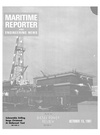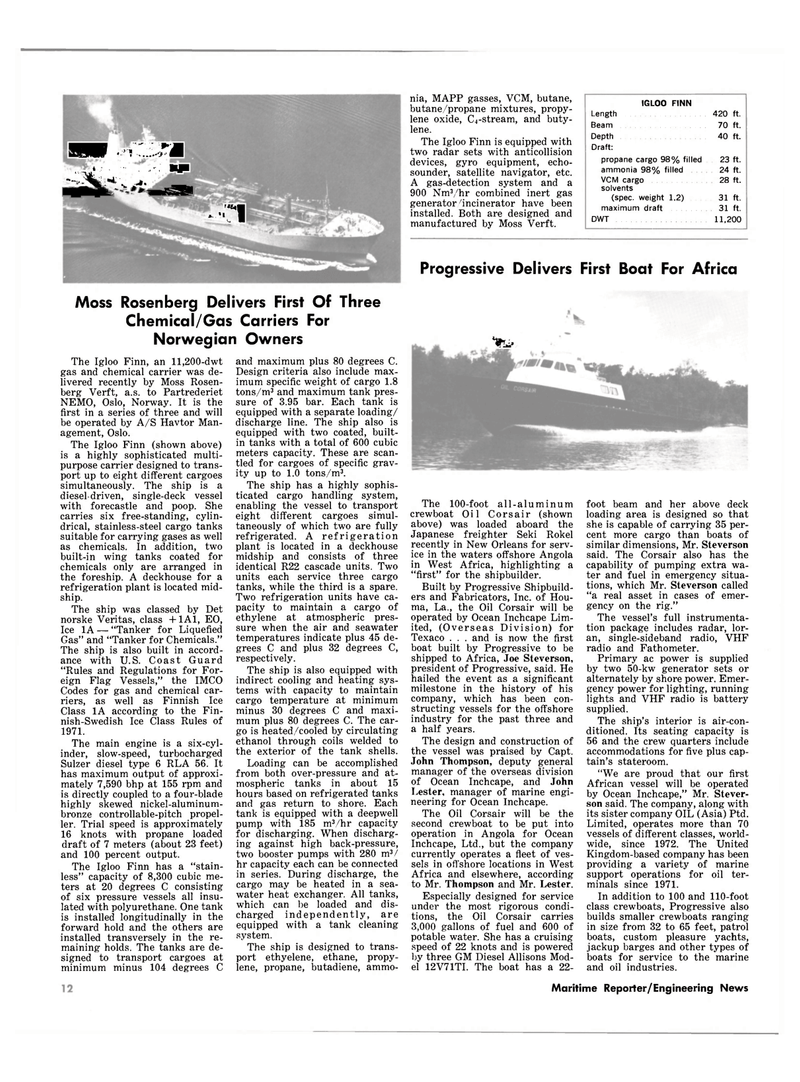
Page 10: of Maritime Reporter Magazine (October 15, 1981)
Read this page in Pdf, Flash or Html5 edition of October 15, 1981 Maritime Reporter Magazine
BMP « ? M i / , is^H *** V-*4 v <*• •££Btt|kt" " - * * "WfeSP * •> 1
Moss Rosenberg Delivers First Of Three
Chemical/Gas Carriers For
Norwegian Owners
The Igloo Finn, an 11,200-dwt gas and chemical carrier was de- livered recently by Moss Rosen- berg Verft, a.s. to Partrederiet
NEMO, Oslo, Norway. It is the first in a series of three and will be operated by A/S Havtor Man- agement, Oslo.
The Igloo Finn (shown above) is a highly sophisticated multi- purpose carrier designed to trans- port up to eight different cargoes simultaneously. The ship is a diesel driven, single-deck vessel with forecastle and poop. She carries six free-standing, cylin- drical, stainless-steel cargo tanks suitable for carrying gases as well as chemicals. In addition, two built-in wing tanks coated for chemicals only are arranged in the foreship. A deckhouse for a refrigeration plant is located mid- ship.
The ship was classed by Det norske Veritas, class 4- 1A1, EO,
Ice 1A — "Tanker for Liquefied
Gas" and "Tanker for Chemicals."
The ship is also built in accord- ance with U.S. Coast Guard "Rules and Regulations for For- eign Flag Vessels," the IMCO
Codes for gas and chemical car- riers, as well as Finnish Ice
Class 1A according to the Fin- nish-Swedish Ice Class Rules of 1971.
The main engine is a six-cyl- inder, slow-speed, turbocharged
Sulzer diesel type 6 RLA 56. It has maximum output of approxi- mately 7,590 bhp at 155 rpm and is directly coupled to a four-blade highly skewed nickel-aluminum- bronze controllable-pitch propel- ler. Trial speed is approximately 16 knots with propane loaded draft of 7 meters (about 23 feet) and 100 percent output.
The Igloo Finn has a "stain- less" capacity of 8,300 cubic me- ters at 20 degrees C consisting of six pressure vessels all insu- lated with polyurethane. One tank is installed longitudinally in the forward hold and the others are installed transversely in the re- maining holds. The tanks are de- signed to transport cargoes at minimum minus 104 degrees C nia, MAPP gasses, VCM, butane, butane/propane mixtures, propy- lene oxide, C4-stream, and buty- lene.
The Igloo Finn is equipped with two radar sets with anticollision devices, gyro equipment, echo- sounder, satellite navigator, etc.
A gas-detection system and a 900 Nm3/hr combined inert gas generator/incinerator have been installed. Both are designed and manufactured by Moss Verft.
IGLOO FINN
Length 420 ft.
Beam 70 ft.
Depth 40 ft.
Draft: propane cargo 98% filled 23 ft. ammonia 98% filled . . . 24 ft.
VCM cargo 28 ft. solvents (spec, weight 1.2) 31 ft. maximum draft 31 ft.
DWT 11,200
Progressive Delivers First Boat For Africa 'ifLi.' and maximum plus 80 degrees C.
Design criteria also include max- imum specific weight of cargo 1.8 tons/m3 and maximum tank pres- sure of 3.95 bar. Each tank is equipped with a separate loading/ discharge line. The ship also is equipped with two coated, built- in tanks with a total of 600 cubic meters capacity. These are scan- tied for cargoes of specific grav- ity up to 1.0 tons/m3.
The ship has a highly sophis- ticated cargo handling system, enabling the vessel to transport eight different cargoes simul- taneously of which two are fully refrigerated. A refrigeration plant is located in a deckhouse midship and consists of three identical R22 cascade units. Two units each service three cargo tanks, while the third is a spare.
Two refrigeration units have ca- pacity to maintain a cargo of ethylene at atmospheric pres- sure when the air and seawater temperatures indicate plus 45 de- grees C and plus 32 degrees C, respectively.
The ship is also equipped with indirect cooling and heating sys- tems with capacity to maintain cargo temperature at minimum minus 30 degrees C and maxi- mum plus 80 degrees C. The car- go is heated/cooled by circulating ethanol through coils welded to the exterior of the tank shells.
Loading can be accomplished from both over-pressure and at- mospheric tanks in about 15 hours based on refrigerated tanks and gas return to shore. Each tank is equipped with a deepwell pump with 185 m3/hr capacity for discharging. When discharg- ing against high back-pressure, two booster pumps with 280 m3/ hr capacity each can be connected in series. During discharge, the cargo may be heated in a sea- water heat exchanger. All tanks, which can be loaded and dis- charged independently, are equipped with a tank cleaning system.
The ship is designed to trans- port ethyelene, ethane, propy- lene, propane, butadiene, ammo-
The 100-foot all-aluminum crewboat Oil Corsair (shown above) was loaded aboard the
Japanese freighter Seki Rokel recently in New Orleans for serv- ice in the waters offshore Angola in West Africa, highlighting a "first" for the shipbuilder.
Built by Progressive Shipbuild- ers and Fabricators, Inc. of Hou- ma, La., the Oil Corsair will be operated by Ocean Inchcape Lim- ited, (Overseas Division) for
Texaco . . . and is now the first boat built by Progressive to be shipped to Africa, Joe Steverson, president of Progressive, said. He hailed the event as a significant milestone in the history of his company, which has been con- structing vessels for the offshore industry for the past three and a half years.
The design and construction of the vessel was praised by Capt.
John Thompson, deputy general manager of the overseas division of Ocean Inchcape, and John
Lester, manager of marine engi- neering for Ocean Inchcape.
The Oil Corsair will be the second crewboat to be put into operation in Angola for Ocean
Inchcape, Ltd., but the company currently operates a fleet of ves- sels in offshore locations in West
Africa and elsewhere, according to Mr. Thompson and Mr. Lester.
Especially designed for service under the most rigorous condi- tions, the Oil Corsair carries 3,000 gallons of fuel and 600 of potable water. She has a cruising speed of 22 knots and is powered by three GM Diesel Allisons Mod- el 12V71TI. The boat has a 22- foot beam and her above deck loading area is designed so that she is capable of carrying 35 per- cent more cargo than boats of similar dimensions, Mr. Steverson said. The Corsair also has the capability of pumping extra wa- ter and fuel in emergency situa- tions, which Mr. Steverson called "a real asset in cases of emer- gency on the rig."
The vessel's full instrumenta- tion package includes radar, lor- an, single-sideband radio, VHF radio and Fathometer.
Primary ac power is supplied by two 50-kw generator sets or alternately by shore power. Emer- gency power for lighting, running lights and VHF radio is battery supplied.
The ship's interior is air-con- ditioned. Its seating capacity is 56 and the crew quarters include accommodations for five plus cap- tain's stateroom. "We are proud that our first
African vessel will be operated by Ocean Inchcape," Mr. Stever- son said. The company, along with its sister company OIL (Asia) Ptd.
Limited, operates more than 70 vessels of different classes, world- wide, since 1972. The United
Kingdom-based company has been providing a variety of marine support operations for oil ter- minals since 1971.
In addition to 100 and 110-foot class crewboats, Progressive also builds smaller crewboats ranging in size from 32 to 65 feet, patrol boats, custom pleasure yachts, jackup barges and other types of boats for service to the marine and oil industries.
Write 358 on Reader Service Card Maritime Reporter/Engineering News

 9
9

 11
11
